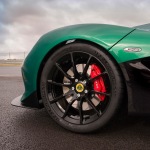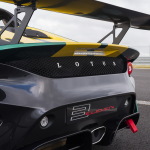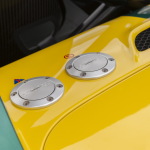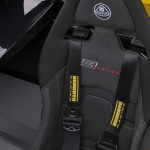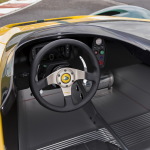Lotus has revealed its latest model at the Goodwood Festival of Speed and it’s none other than the track-focused 3-Eleven, the fastest and most expensive machine that came out of Hethel.
As with the previous model, the 3-Eleven is essentially a more focused, open-cockpit version of the Exige chassis, with the revised 3.5-litre V6 pumping out 450hp at 7,000rpm and 332lb ft of torque from 3,500rpm through to 6,500rpm. The engine is mated to a close-ratio six-speed manual gearbox for the road-going version as Lotus will also offer a Race derivative which uses a six-speed sequential transmission with paddles and a semi-dry sump.
The dry weight of the Race model is set to be below 900kg, giving the 3-Eleven a power-to-weight ratio of more than 500hp per tonne. 0 to 60mph comes in less than 3.0 seconds while top speed is rated at 174mph (280km/h) for the Race model and 180mph (290km/h) for the road-legal one.
Jean-Marc Gales, Lotus boss said: “This new car is a giant slayer, capable of embarrassing far more expensive rivals. It condenses our engineering know-how into one, hard-core package, and is so focused that it won’t suit everyone. This is a perfect demonstration of the faster and lighter concept, something which will be crucial to all Lotus cars in the future.”
The new 3-Eleven is officially the fastest Lotus ever built as it lapped Hethel’s test track in just 1min 22secs. The road-legal version features a roll cage with twin side bars for better side protection while the Race version has additional bars to meet with the international requirements for racing.
A set of lightweight double wishbones were used front and back, as well as an adjustable front anti-roll bar and Eibach spring with adjustable Ohlins dampers. The grooved brake discs measure 332mm front and rear with AP Racing four-piston calipers on them while the Race version has upgraded brake pads.
Lotus says that the whole body is made from “very light weight composite materials” allowing it to be 40% lighter than the GRP equivalent. Aerodynamically, the 3-Eleven produces up to 215kg of real downforce at 150mph (240km/h) in Race spec. There is a choice between two front splitter configurations, depending on the spec of the model with the same happening for the rear fixed wing.
The interior is as minimal as you would imagine, with Lotus offering as an option a passenger seat which remains removable so the driver can fit an also optional tonneau panel to improve overall aerodynamics. A colour TFT screen provides the driver with all the important information, with the steering wheel to be removable as it is the norm with this kind of track-day cars.
The new Lotus 3-Eleven will be hand-made when production starts in February 2016 with prices starting at £82,000 for the road-going model and £115,200 for the Race version. Production will be strictly limited to 311 units in total.





